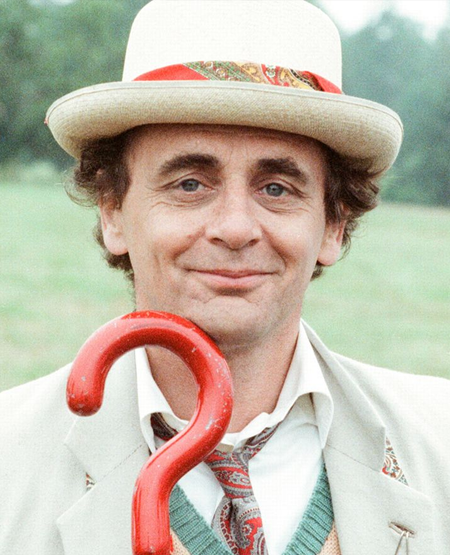
SYLVESTER MCCOY
DOCTOR WHO
APPEARING: FRI/SAT/SUN
Sylvester McCoy was born Percy James Patrick Kent-Smith on 20 August 1943, the son of Molly Sheridan and Percy James Kent-Smith, an Irish couple living in Dunoon, Scotland. His father was killed in the Second World War a couple of months before he was born, and he was brought up by his mother, his grandmother – Mary Sheridan – and aunts. He attended St. Mun’s, a local Dunoon school. The headmistress, Rosie O’Grady, was keen that her young charges obtain decent jobs upon leaving the school and so organized regular talks from people in all manner of professions.
McCoy expressed an interest in every job, and as a result eventually found himself given an afternoon off school to go to see a local priest about entering the priesthood. He left school, joined Blair’s College, a seminary in Aberdeen, and between the ages of twelve and sixteen trained to be a priest. It was while at Blair’s College that he realized that there was more to life than could be found in Dunoon and discovered classical music and history, which fascinated him. He eventually decided to become a monk and applied to join a Dominican order, but his application was rejected as he was too young. He went instead to Dunoon grammar school, where he discovered the delights of his female fellow pupils and quickly decided that he didn’t want to be a priest or a monk after all.
On finishing his education he took a holiday down to London, from which he never returned. McCoy approached a youth employment center looking for a job and impressed by the fact that he had attended a grammar school, they instantly found him a job in the City working for an insurance company. He trained in this job and stayed there until he was twenty-seven before deciding that it wasn’t really for him. With the help of a cook at London’s Roundhouse Theatre, McCoy gained a job there selling tickets and keeping the books in the box office.
McCoy joined the Ken Campbell Roadshow. Along with Bob Hoskins, Jane Wood, and Dave Hill, he would start performing a range of plays with the umbrella theme of “modern myths”. McCoy found himself in a double-act with Hoskins. After Hoskins left, and being booked at a circus, director Ken Campbell improvised a circus-based act about a fictitious stuntman called Sylvester McCoy and thought it would be amusing if the program stated that this character was played by “Sylvester McCoy”. While at the Royal Court Theatre, one of the critics missed the joke and assumed that Sylvester McCoy was a real person. McCoy liked the irony of this and adopted the name of his stage identity. During one of their UK engagements, the Roadshow team was invited up by Joan Littlewood, who was directing a production of “The Hostage”, before the performance of her play. This led McCoy to bona fide theater, and he was subsequently invited to appear in numerous plays and musicals.
McCoy was starring at the National Theatre in “The Pied Piper”, a play written especially for him, when he learned that the BBC was looking for a new lead actor to replace Colin Baker, who had been unceremoniously dumped from Doctor Who (1963) on the orders of Michael Grade. McCoy won the role as the Seventh Doctor despite reservations from Grade and Head of Drama Jonathan Powell, who were by this time monitoring producer John Nathan-Turner’s decision-making very closely. McCoy’s first season took the slightly pantomimic style of Baker’s final season, Trial of a Time Lord, even further and received a very dubious reception from the press and fans. Nathan-Turner put McCoy in a pullover covered in question marks, which McCoy later admitted he didn’t like. By the time of McCoy’s second season, the new script editor, Andrew Cartmel, was trying to make the series darker and more complex. In the third season, McCoy’s costume was changed from a fawn jacket and paisley scarf to a dark brown jacket and an altogether more muted and subdued image, but the pullover remained. Despite forming a close bond with co-star Sophie Aldred and the general standard of the stories rising again towards the end, the series was obviously starved of funds and ratings were fairly poor throughout the McCoy era, with the series being trounced by ITV’s Coronation Street (1960). The BBC’s opinion of Doctor Who (1963) was that it was an embarrassment. In 1989, the new Head of Series, Peter Cregeen, pulled the plug.
After Doctor Who (1963) McCoy worked extensively in theater and on television. In theater he appeared in “The Government Inspector” twice in tours during 1993 and 1994, and in between these he starred as the Narrator, Thomas Marvel, in the stage version of H.G. Wells’s “The Invisible Man.” In 1995 he starred in Zorro: The Musical.”
On television his credits include Frank Stubbs (1993) and Rab C. Nesbitt (1988). He also created the character of Crud in the cult television series Ghoul-Lashed () for Sky TV. In 1996 he was contracted to reprise his role as the Doctor, handing over to an eighth incarnation of the Time Lord in the earthly form of his friend Paul McGann. Also in 1996, McCoy devised and presented Reeltime Pictures’ I Was a ‘Doctor Who’ Monster (1996) – a special video tribute to the men and women who had played the monsters of Doctor Who (1963).
$60
$85
CLICK HERE for photo op tickets!
